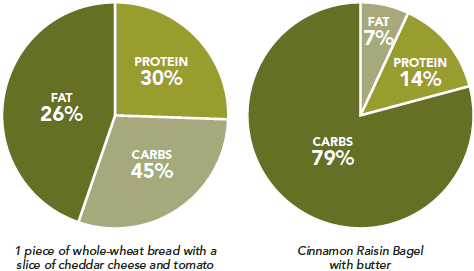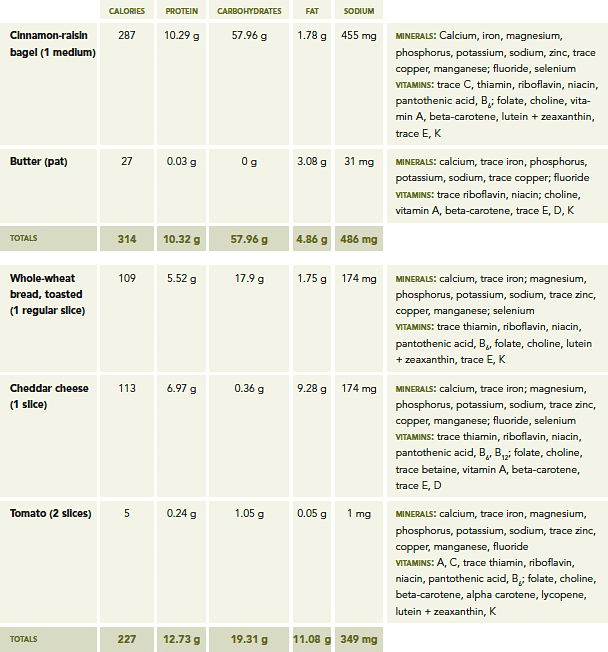 |
 |
Healthy Eating: A Matter of BalanceBy Sara Tiner With food at every turn, Americans seem to have surmounted the age-old problem of not getting enough to eat. But both deficiency and over-consumption of foods are still a problem in some groups of people. Dietary surveys and research reveal that the elderly, those who are extremely poor, alcoholics, and people who strictly limit food intake by choice can all be in danger of becoming deficient in vitamins and minerals needed for proper body functioning. But more common are the problems associated with overconsumption of food. Eating more than the body needs for daily repair and growth can lead to obesity, which in turn is implicated in a host of diseases related to the heart and cardiovascular system, cancer and diabetes. And unlike the genetics, gender, or age, diet is something we can control and use for our benefit. That's why making healthy dietary choices is so important - your quality of life can literally depend on it.
Unlike plants, we can't use sunlight to make our own food (wouldn't that be neat?). We need to take in nutrients that our body can then break apart and use to fuel the millions of biochemical reactions that keep us moving, growing and learning. Our food needs to give us energy now (the body prefers carbohydrates for this), provide building blocks for repair (proteins that break down into amino acids), and allow us to store energy for later (fats). But we also need vitamins and minerals - these complex substances are needed for chemical reactions in the body (like the B-vitamin complex and its action in energy generation and enzyme activity), and in some cases make up part of our physical structure (calcium in bones, for example). Balanced eating means taking in the amount of nutrients your body needs for optimal functioning, when your body needs it, and no more. Simple to understand, hard to do! Every person requires different levels of nutrient intake, and your age, activity level, whether you're a man or woman, and your current weight all play a role in what your plate should look like. One thing is for sure, though: It shouldn't look like one big bagel. Here's why. Unbalanced Eating: Too Much of Some Nutrients, Not Enough of Others Not to pick on bagels, but in general, they're unbalanced -nutritionists would call this "calorie dense / nutrient light," meaning that within a medium, cinnamon-raisin bagel with butter, most of the 314 calories come from one nutrient: carbs. Exchange that bagel for something like a slice of whole-grain bread with cheese and tomato and you get a more balanced profile of nutrients and a lot more vitamins and minerals - key to a nutrient-dense food. And nutrient density is what you want. Balanced vs. unbalanced eating: A classic example Think bagels are healthy? Maybe compared to a donut, but they’re nutritionally unbalanced compared to whole-wheat toast with cheese and tomato. Take a look (and see the table on the next page for a more detailed breakdown):

"Superfoods" aside, no food is perfect from a nutrition standpoint. To get the vitamins, minerals and nutrients we need every day, we have to eat foods that contain those things every day. But we have to watch our total calories - eating more than we need will lead to weight gain. Imbalanced nutrition (in either direction) causes your body to work harder. Eating a diet that's devoid of vitamins and minerals makes your body prioritize its activity - for example, without enough calcium, your body will take it from your bones to make sure your muscles have enough. Conversely, eating more than your body needs means extra energy goes toward processing nutrients, storing them and dealing with the long-term effects of extra weight (joint pain and inflammatory chemical changes, for example). The key is to get the right amounts of macronutrients (carbs, protein and fat) and micronutrients (vitamins and minerals) in the right balance so your body can function effectively and efficiently. Better Balance = Better Nutrition As the pie charts on the previous page and the table below illustrate, choosing to eat a slice of whole-wheat bread with cheddar cheese and tomato for breakfast instead of a cinnamon-raisin bagel with butter is an infinitely more balanced option.

The Brain and The Belly If food were merely fuel, we'd probably all be at our optimal weight. We'd belly up to the table, eat 'till we were full, and then hop up and move on to the next activity. But food is often more than fuel. It's comfort, enjoyment, fellowship, etc. It's about how we show love, celebrate, and console ourselves and others. And more often than not, we're eating it on the run or at a gulp so we can move on to bath time or the next activity. So, the battle for balance has two fronts: the belly and the brain. They need to work together to keep your food intake balanced and your body healthy. You need your brain to learn what your body needs every day - maybe by keeping a food journal, paying attention to how you feel after each meal, or by watching the scale. And you need your belly to tell you when you're satisfied and what foods do the trick.
Use Balanced Eating as a Tool for Lifelong Health By thinking about what you eat, how much of it you need, and whether or not your food is nutrient dense, you can start to control one major factor of chronic disease. And that's one powerful risk factor in your favor. According to research, premature deaths that are attributable to personal choices (like smoking, diet, exercise, alcohol/drugs, etc.) have increased by 40 percent in the past 100 years; so while it's estimated that 5 percent of deaths in 1900 were due to personal choices, by 2000 that number increased to 45 percent. This suggests that our health is to a large extent under our control. So let's take control of what we can, and have fun doing it. Take a cooking class, resolve to try one new fruit, grain, or bean a week, or just make one healthy food addition/substitution a week - like eating green salad before a slice of pizza. Simple changes now can turn into long-term habits that help safeguard our quality of life for the future.
Sara Tiner, BA, BS, MS, is the coordinator of scientific communication for a whole-food supplement manufacturer in Wisconsin. With undergraduate degrees in biology and English from Ripon College, and a master's degree in journalism from Columbia University, she's worked as a science writer in both print and radio over the past decade, and moonlights as a freelance contributor to various publications. |